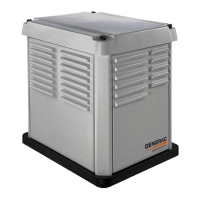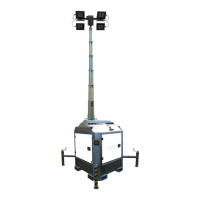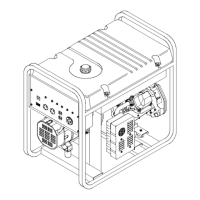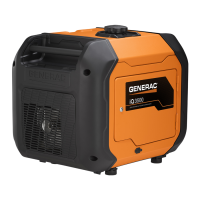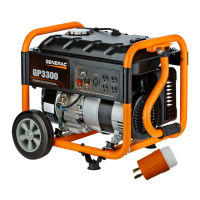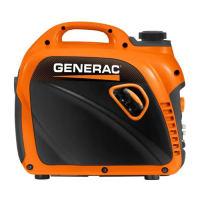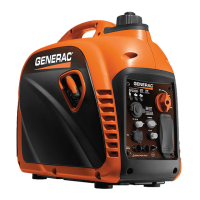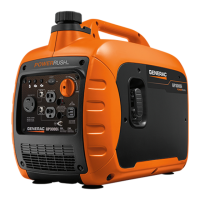PART 2
AC GENERATORS
Page 30
Section 2.4
Diagnostic Tests
INTRODUCTION
This section familiarizes the service technician with acceptable
procedure for the testing and evaluation of various problems
that can occur on the standby generators with air-cooled
engines. Use this section in conjunction with Section 2.3,
“Troubleshooting Flow Charts.” The numbered tests in this
section correspond with those of Section 2.3.
Some test procedures in this section may require the use of
specialized test equipment, meters or tools. Most tests can be
performed with an inexpensive Volt-Ohm-Milliammeter (VOM).
An AC frequency meter is required where frequency readings
must be taken. To measure AC loads it is acceptable to use a
clamp-on ammeter.
Testing and troubleshooting methods covered in this section
are not exhaustive. No attempt has been made to discuss,
evaluate and advise the home standby service trade of all
conceivable ways in which service and trouble diagnosis must
be performed. Accordingly, anyone who uses a test method
not recommended herein must first satisfy himself that the
procedure or method he has selected will jeopardize neither his
nor the products safety.
SAFETY
Service personnel who work on this equipment should be
aware of the dangers of such equipment. Extremely high and
dangerous voltages are present that can kill or cause serious
injury. Gaseous fuels are highly explosive and can ignite by the
slightest spark. Engine exhaust gases contain deadly carbon
monoxide gas that can cause unconsciousness or even death.
Contact with moving parts can cause serious injury. The list of
hazards is seemingly endless.
When working on this equipment, use common sense and
remain alert at all times. Never work on this equipment
while you are physically or mentally fatigued. If you do not
understand a component, device or system, do not work on it.
AC TROUBLESHOOTING
It is always good practice to continue to ask questions during
the troubleshooting process. When evaluating the problem
asking some of these questions may help identify the problem
quicker.
•What is the generator supposed to do?
•What fault (Alarm) is shutting the generator down?
•Is the fault a symptom of another problem?
•Does the generator have the same fault consistently?
•When does the fault occur?
•Why would this happen?
•How would this happen?
•What type of test will either prove or disprove the cause of
the fault?
TEST 1 – CHECK MAIN CIRCUIT BREAKER
Discussion
Often the most obvious cause of a problem is overlooked. If the
generator main line circuit breaker is set to OFF or “Open”, no
electrical power will be supplied to electrical loads. If loads are
not receiving power, perhaps the main circuit breaker is open
or has failed.
Procedure
The generator main circuit breaker is located in the external
customer connection box. If loads are not receiving power,
make sure the breaker is set to “On” or “Closed”.
If you suspect the breaker may have failed, it can be tested as
follows (see Figure 19):
1. Set a Volt-Ohm-Milliammeter (VOM) to its “R x 1” scale
and zero the meter.
2. With the generator shut down, disconnect all wires from
the main circuit breaker terminals, to prevent interaction.
3. With the generator shut down, connect one VOM test
probe to the Blue Wire 11 terminal of the breaker and the
other test probe to the Wire E1 terminal.
4. Set the breaker to its “On” or “Closed” position. The VOM
should read CONTINUITY.
5. Set the breaker to its OFF or “Open” position and the VOM
should indicate INFINITY.
6. Repeat Steps 4 and 5 with the VOM test probes
connected across the breaker’s Black Wire terminal and
the E2 terminal.
Results
1. If the circuit breaker tests good, refer back to flow chart.
2. If the breaker tests bad, it should be replaced.
LOAD SIDE
E1 E2
LINE
BLUE BLACK
Figure 19. Generator Main Circuit Breaker Test Points
TEST 4 – FIXED EXCITATION /ROTOR AMP
DRAW TEST
Discussion
Supplying a fixed DC current to the rotor will induce a magnetic
field in the rotor. With the generator running, this should create
a proportional voltage output from the stator windings.
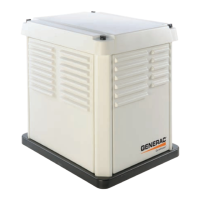
